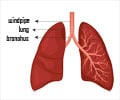For the first time, researchers used genome sequencing technology to track the changes in a bacterial population following the introduction of a vaccine.

The study follows how the population of pneumococcal bacteria changed following the introduction of the 'Prevnar' conjugate polysaccharide vaccine, which substantially reduced rates of pneumococcal disease across the U.S. The work demonstrates that the technology could be used in the future to monitor the effectiveness of vaccination or antibiotic use against different species of bacterial pathogens, and for characterizing new and emerging threats.
The study appears online May 5, 2013 in Nature Genetics.
"This gives an unprecedented insight into the bacteria living and transmitting among us," said co-author William Hanage, associate professor of epidemiology at HSPH. "We can characterize these bugs to an almost unimaginable degree of detail, and in so doing understand better what helps them survive even in the presence of an effective vaccine."
Pneumococcal disease is caused by a type of bacteria called Streptococcus pneumoniae, which is present in many people's noses and throats and is spread by coughing, sneezing, or other contact with respiratory secretions. The circumstances that cause it to become pathogenic are not fully understood. Rates of pneumococcal disease—an infection that can lead to pneumonia, meningitis, and other illnesses—dropped in young children following the introduction of a vaccine in 2000. However, strains of the bacteria that are not targeted by the vaccine rapidly increased and drug resistance appears to be on the rise.
The research, led by HSPH co-senior authors Hanage; Marc Lipsitch, professor of epidemiology; and Stephen Bentley, senior scientist at the Wellcome Trust Sanger Institute, aimed to better understand the bacterial population's response to vaccination. Whole genome sequencing—which reveals the DNA code for each bacterial strain to an unprecedented level of detail—was used to study a sample of 616 pneumococci collected in Massachusetts communities from 2001 to 2007.
Advertisement
"The widespread use of whole genome sequencing will allow better surveillance of bacterial populations — even those that are genetically diverse — and improve understanding of their evolution," said Lipsitch. "In this study, we were even able to see how quickly these bacteria transmit between different regions within Massachusetts and identify genes associated with bacteria in children of different ages."
Advertisement
Source-Eurekalert










